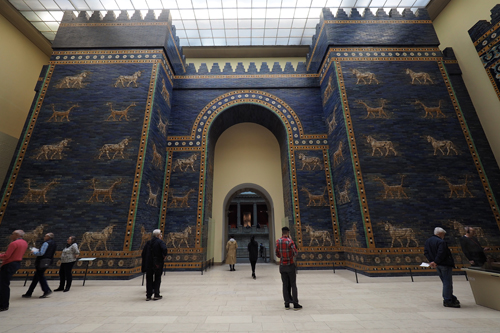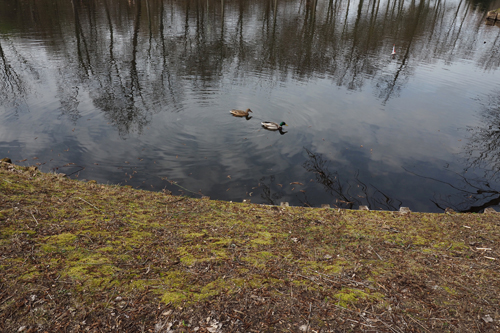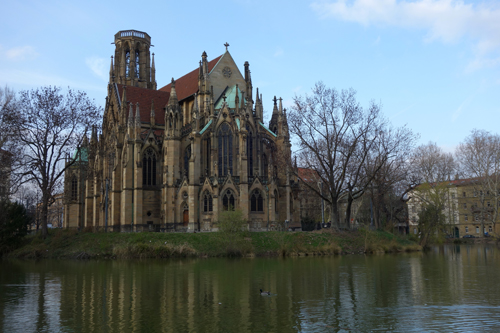March 20, 2019. Larnaca, Cyprus to Berlin, Germany.
Breakfast at Costantiana Beach Hotel and Apartments was meant to start at 7:30 am. Normally this would have given us enough time for a quick bite before heading to the airport for our flight to Germany.
Unfortunately the guy who was looking after breakfast must have slept in, as he didn’t arrive until 7:45.
Breakfast was a rush.
Fortunately the airport was only minutes from the hotel and it was an easy drive to get there.
We were there, even after filling the tank, at 8:30.
Dropping the Citroën off at Avis was even easier.
So far on this trip Avis have been great. Despite the fact, that even after 13 years with an Avis Preferred Card, I have never had an upgrade.
We had driven 428 kilometres around Cyprus and it had been a wonderful adventure.
The car performed well, despite a dodgy clutch. The roads had been a joy to drive on and the drivers were courteous.
The scenery was spectacular as well.
Our flight to Berlin took us via Athens again. This time the layover was only 1:40 minutes.
Not really much time to do anything other than go from one flight to another.
We arrived at Tegel Airport in Berlin mid afternoon and decided to take public transport to Hayden and Andrea’s place. Being a working day we didn’t want to arrive too early.
This wasn’t to be.
They kept on cancelling the bus, so we went back into the the airport, had a drink to fill in time and then caught a cab.
March 21, 2019. Berlin, Germany.
The only tourist destination we intended to visit, while in Berlin, was the Pergamon Museum on Museum Island.
We had visited Pergamon, Turkey in April, 2012 and were impressed with the site but unimpressed with the fact that most of the artifices had been looted by the Germans.
This was our chance to see those stolen artefacts.
The official line is that they were taken under the approval of the Ottomans.
When we arrived we were not impressed.
€19 ($30) each for the museum and half it was closed for renovations. The work started in 2013 and was extending to 2019 and beyond.
At the Pergamon Museum monumental exhibits, like the Altar of Pergamon, are their claim to fame.
This was the part that was shut.
What was available of the Pergamon exhibition was in the ground floor. Upstairs was devoted to art from the Islamic era.
Within that section there was a lot of space dedicated to Syria and its destruction, due to the ongoing war.
A theme we had just recently encountered in the Museum of Islamic Art in Doha.
In the end the saving grace was the Panorama, an adjunct to the main museum. It was housed in a purpose built facility that was just up the road.
The main feature was a 360° panorama.
Not only was it 360° in circumference it was also about 50° in height. It was done in such a way that you needed to climb the four stories of the central tower to get the best view of the panorama.
The entire scene of Pergamon was a combination of 3D digital illustration and photography. Real people, dressed in period costume, had been combined with a highly realistic interpretation of this 2,000 year old Roman Hellenistic city.
It was very impressive.
It was designed by Yadegar Assisi and originally staged between September 2011 and September 2012. This was a revised version that started in November 2018.
Yadegar Assisi is an artist, architect and university lecture. Born in Vienna to Persian parents in 1955, his tertiary education was in Germany and he currently lives in Berlin.
He has created some of the largest 360° panoramas in the world, some measuring 32 meters high and up to 110 meters in circumference.
The Pergamon Museum was built between 1910 and 1930 and designed by Alfred Messel and Ludwig Hoffman.
It replaced the Kaiser-Friedrich-Museum on Museum Island, which opened in 1904. It soon became clear that with all the artefacts that were being repatriated to Germany that this museum wasn’t large enough – so the idea of the Pergamon was born.
The museum was severely damaged during the bombing of Berlin at the end of the Second World War. But most of the exhibits had been moved off site and the larger displays walled-in to protect them.
At the end of the war, during the Russian occupation, many of the artefacts were relocated to Russia, a lot still remain there.
March 22, 2019. Berlin, Germany.
Chilling out was the order of the day.
Hayden had taken both the Friday and Monday off, so we spent most of the day just hanging around the apartment.
I was hoping to get a much needed haircut but the place I had chosen was booked out.
I therefore made an appointment for Monday.
In the afternoon we all went to do the weekly shopping.
Now this might sound a bit boring but we have found that you learn a lot about a city and its people when you visit a supermarket.
What food they like, how important and available are fresh fruit and veg. Plus trends in health, luxury goods and even recycling.
March 23, 2019. Berlin, Germany.
It was a Saturday so a good opportunity for the ‘workers’ to sleep in.
After a late breakfast we went into Kurfürstendamm, the main retail strip in the heart of Berlin.
After some shopping and a lot of walking around we went for a late lunch at Schildkröte, or Turtle, a typical Berliner restaurant.
The literal translation of Schildkröte is ‘Shield Toad’.
Germans have a very strange way of naming some animals. Everyone knows that a Pig is Schwein, but a porcupine is a Stachelschwein, which means ‘Spike Pig’.
March 24, 2019. Berlin, Germany.
Another relaxing day with H&A in Berlin.
Todays activity was to walk around the Tiergarten, Berlin’s most popular inner city park. At 210 hectares it is the city’s largest park, next to Tempelhofer, formerly the Tempelhof airport, which we visited in September 2017.
It was just the second day of spring and there were signs of it everywhere.
The trees, flowers, wildlife and even the Berliners were enjoying the slightly warmer weather.
The Tiergarten was originally developed as a hunting area for the Elector of Brandenburg in 1527.
In 1740 Frederick the Great (1712-1786) not being a great fan of hunting, opened part of the part as a public garden.
The park remained the property of the monarchy until 1881. At this time Emperor William I abolished his rights to the forests and it became state land.
As a result of the Second World War the Tiergarten was severely damaged. Much of the forrest was cut down for firewood and the land turned over to agriculture.
Only 700 trees survived of the 200,000 that were originally in the park before the war.
The gardens stagnated until the fall of the Berlin Wall in 1989. Then many of the embassies, that had been abandoned, were re occupied and the area gained a new lease of life.
March 25, 2019. Berlin, Germany.
The warmer weather of 12°C, from the previous day had gone, now it was 5°C, real feel 0°C.
This was fine as we had nothing planned, except my haircut at ROWDY, a hipster barbers shop about 15 minutes walk from the apartment.
My barber spoke perfect English, like so many in this area of Berlin.
March 26, 2019. Berlin to Stuttgart, Germany.
Sadly our time with H&A had ended and we were off to Stuttgart to see the city and visit Rebecca and Felix with their growing family.
This time we were on the train, first to Nuremberg, then on to Stuttgart.
Like the Japanese Shinkansen there is a sign on the platform telling you where your carriage will stop. Unlike the Japanese trains it’s not that accurate.
Ours was at the opposite end of the platform from where we were told we should be.
They do move as fast as the Bullet Trains – we were travelling at over 210 kph.
The second leg of our journey, south to Stuttgart, was not on a high speed train. It was on a local line that was slower and without WiFi.
However it did have mains voltage power to charge our computers and information screens with the connections available at the next stop.
Once we were settled into the Novum Hotel Rega, we went for a walk around the area.
Just around the corner we found the Church of St John. It was designed by Christian Friedrich von Leins in the Gothic Revival style and constructed between 1864 and 1876.
The church is on a peninsula of Lake Feuersee or Fire Lake.
We intended to go to a typical German restaurant, Stuttgarter Stäffele, but it was booked out.
We ended up at another one, just around the corner. It was again typical German but not as fancy.
It turned out to be great, even though the portions were mega.
We were given a ‘Doggy bag’ to take home but left it at the restaurant.
We were full enough.
March 27, 2019. Stuttgart, Germany.
We decided to use public transport in Stuttgart and bought ourselves a day pass on the underground.
Never once did we have to validate our ticket or even have it checked. Obviously the Germans are very trustworthy.
Our first stop was the Mercedes Benz Museum.
The museum showcases 130 years of automotive history, from the very German perspective of Gottlieb Daimler and Carl Benz.
There are 16,000 square meters in this purpose build facility, set in the heart of the Mercedes Benz factory area.
Travelling by lift to the top floor you descend nine levels through time, from 1886 to present day innovations.
The tri-star of Mercedes is brought to life with the application of Daimler’s ‘Grandfather Clock’ motor. This amazing piece of technology was used in transport on ‘land’, ‘sea’ and ‘air’ (the three points of the star).
One fact of automative trivia that really stuck in my mind was the placement of the steering wheel.
In the early years it started off in the centre of the vehicle. It then moved to the right hand side. This was done because it was felt that the driver needed to see the curb more clearly. Only after traffic became more congested did it move to the left. This was done so the driver could see the oncoming traffic.
It was a fascinating exhibition and I only wish that we were in Stuttgart long enough to also visit the Porsche Museum as well – I don’t think Thea would agree.
After the museum we then got the S Bahn back to the centre and wandered around there for a few hours.
There isn’t a lot of historical building remaining as so much was lost during WWII.
Stuttgart sits on the Neckar River and since the 6th millennium BC has been an important agricultural area. But today it’s manufacturing that gives it the status of being one of the wealthiest European cities by GDP.
Today it is known as the ‘Cradle of the Automobile’ being the birthplace of the motor vehicle and the home of Mercedes-Benz , Daimler AG and Porsche.
We had another run-in with the law, however this was of our own making.
We found a wallet lying open on the footpath, just near Palace Square. It contained cards, money and more. Fortunately we had just past a couple of police officers nearby so we raced back and handed over the find.
They were rather shocked I think.
That night we had dinner with Rebecca and Felix and Rebecca’s parents Harold and Barbara.
It was great to catch up with old friends and to see Rebecca and Felix’s growing family.













